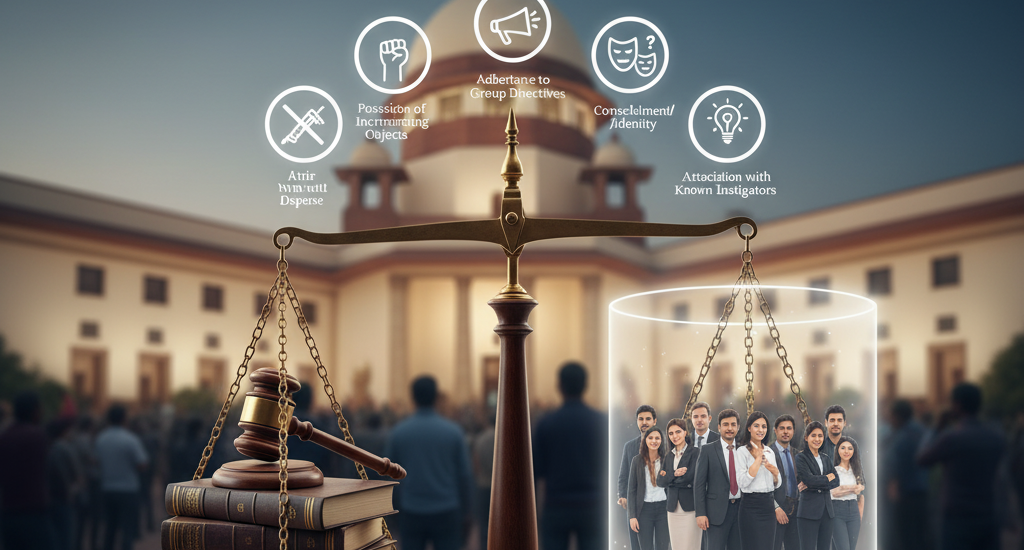Beyond Mere Presence: The Supreme Court’s Crucial Test to Exempt Innocent Bystanders from ‘Unlawful Assembly’ Liability
- October 8, 2025
- Posted by: lawandhonour.com
- Category: LEGAL NEWS

Safeguarding Liberty: Interpreting Vicarious Liability under Section 149 of the Indian Penal Code
The legal doctrine of “unlawful assembly” is a powerful tool in criminal law, imposing collective or vicarious liability on every member for an offence committed by any one member of the assembly in prosecution of their common object. However, a significant legal challenge in cases involving large crowds, riots, or public disturbances is distinguishing a culpable member of the unlawful assembly from an innocent spectator or passive bystander.
The Supreme Court of India has consistently addressed this critical distinction, laying down clear parameters to prevent the miscarriage of justice and protect the liberty of individuals who were merely present at the scene. The core principle revolves around establishing the ‘common object’ of the assembly.
The Core Principle: Common Object, Not Mere Presence
The judicial pronouncements are unequivocal: Mere presence at the scene of an unlawful assembly does not automatically render a person a member of that assembly, nor make them guilty of an offence committed by it.
Liability under Section 149 of the Indian Penal Code (IPC) hinges on proving that the accused shared the common object of the assembly. A mere bystander or an innocent onlooker, to whom no specific role is attributed, cannot fall within the ambit of this section. The onus is entirely on the prosecution to establish the accused’s shared common object through direct or circumstantial evidence.
The Supreme Court’s Cautionary Parameters
To effectively distinguish the guilty member from the innocent bystander, the Supreme Court has laid down a set of cautionary parameters for courts to scrutinise the evidence, especially in cases where a large number of people are implicated with vague or general allegations.
While a rigid “7-factor test” may not be formally codified, the judicial analysis consistently focuses on a set of core factors to infer the existence of a common object and the active participation of the accused. The test applied to determine if a person is a passive onlooker is the same as that used to ascertain the existence of a common object.
Here are the key judicial parameters that courts must consider:
1. Proof of Common Object
The most critical factor. The prosecution must prove that the assembly had a pre-determined or spontaneously formed common object to commit one of the unlawful acts specified in Section 141 of the IPC. Without a proven common object, the assembly cannot be classified as “unlawful.”
2. Overt Acts in Furtherance of the Common Object
It is safest to convict only those accused who are attributed with specific overt acts that are in furtherance of the common object of the unlawful assembly. The act must be directly connected with the common object, or appear to have been done with a view to accomplish that common object.
3. Consistency of Presence and Identification
The accused’s presence at the scene must be consistently established from the initial stages of the investigation, such as the First Information Report (FIR). In cases involving a large number of accused, the court must look for cogent and credible material to lend assurance to the identification.
4. Time and Place of Formation
The circumstances surrounding the time and place at which the assembly was formed can be a key indicator of its object. For instance, gathering late at night at the victim’s house armed with weapons suggests an unlawful object, unlike an assembly on a public road where presence is natural.
5. Conduct and Behaviour of the Accused
The conduct and behaviour of the individual accused at or near the scene is highly material. Did they raise slogans, wield a weapon, or actively prevent others from helping the victim? Conversely, did the person join out of idle curiosity, without knowledge of the common criminal object?
6. Nature of Weapons
If the accused was armed, the nature of the weapon (deadly or otherwise) and the manner in which it was used or displayed (a show of force) is a strong pointer towards sharing the common object.
7. Subsequent Dissociation
For an accused who may have initially been part of the assembly, the point of time at which they discovered the unlawful object and whether they attempted to prevent the act or dissociated themselves from the assembly by leaving is a crucial exculpatory factor.
Protecting the Innocent: A Prudent Approach
The Supreme Court has mandated that when faced with general allegations against a multitude of people, courts must adopt a rule of caution and meticulously scrutinise the evidence. This cautionary rule, however, does not dilute the doctrine of constructive liability under Section 149, where proof of an overt act by every single individual is not strictly indispensable.
In essence, while the law holds members of an unlawful assembly vicariously liable, the courts act as the essential check, insisting on tangible proof that the accused was an active participant with a shared criminal objective, rather than an unfortunate, innocent spectator who happened to be in the wrong place at the wrong time. This legal posture reinforces the constitutional mandate to protect the liberty of every individual.

